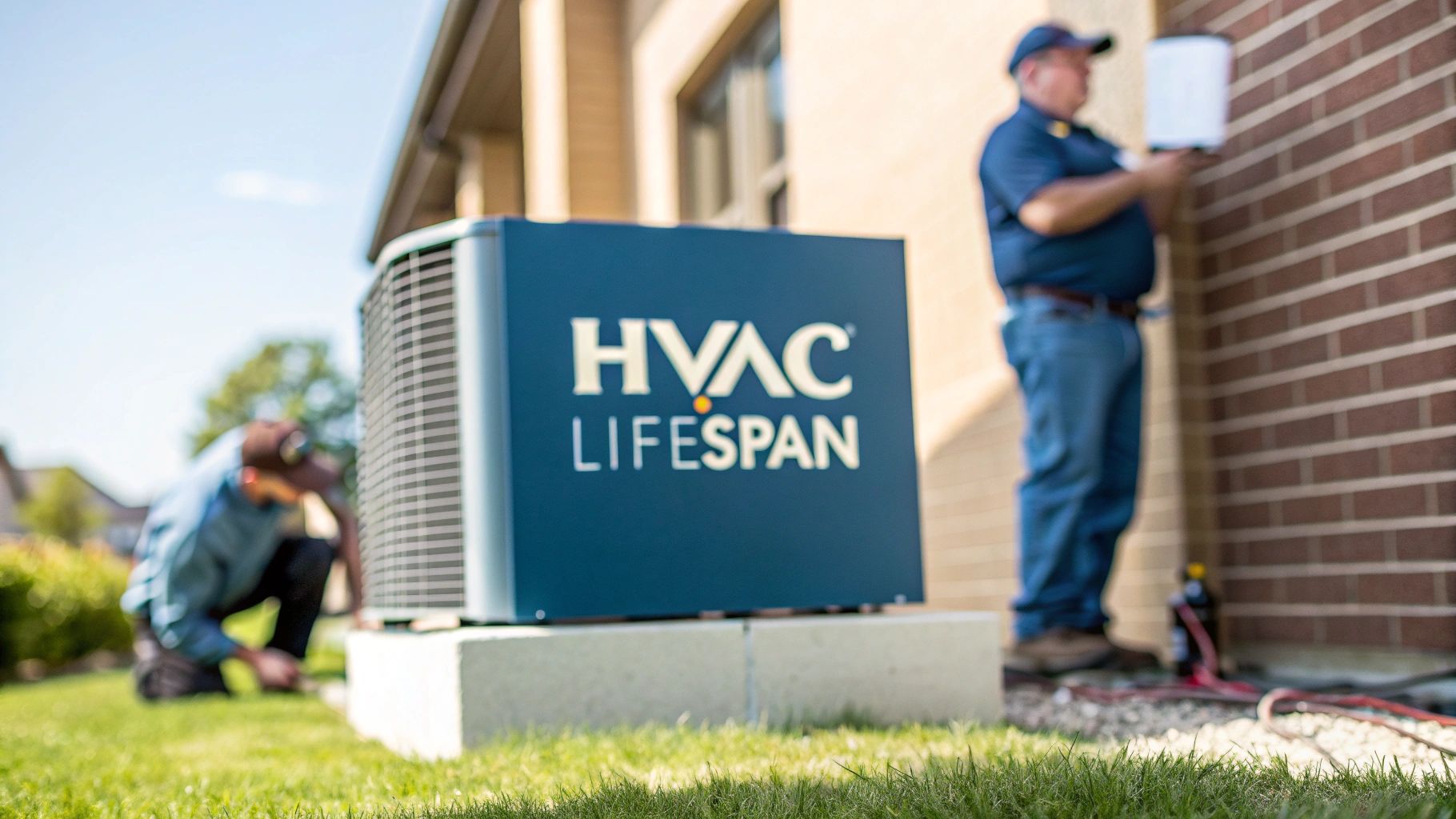Have you ever wondered why your home seems to gather dust so quickly? Or why your allergies flare up even when you're inside? The answer is often floating right in the air you're breathing, and the fix is simpler than you might think. High-quality filters for air vents in your home are your first line of defense, trapping all that gunk before it ever circulates into your living space.
Why Air Vent Filters Are Your Home's First Defense
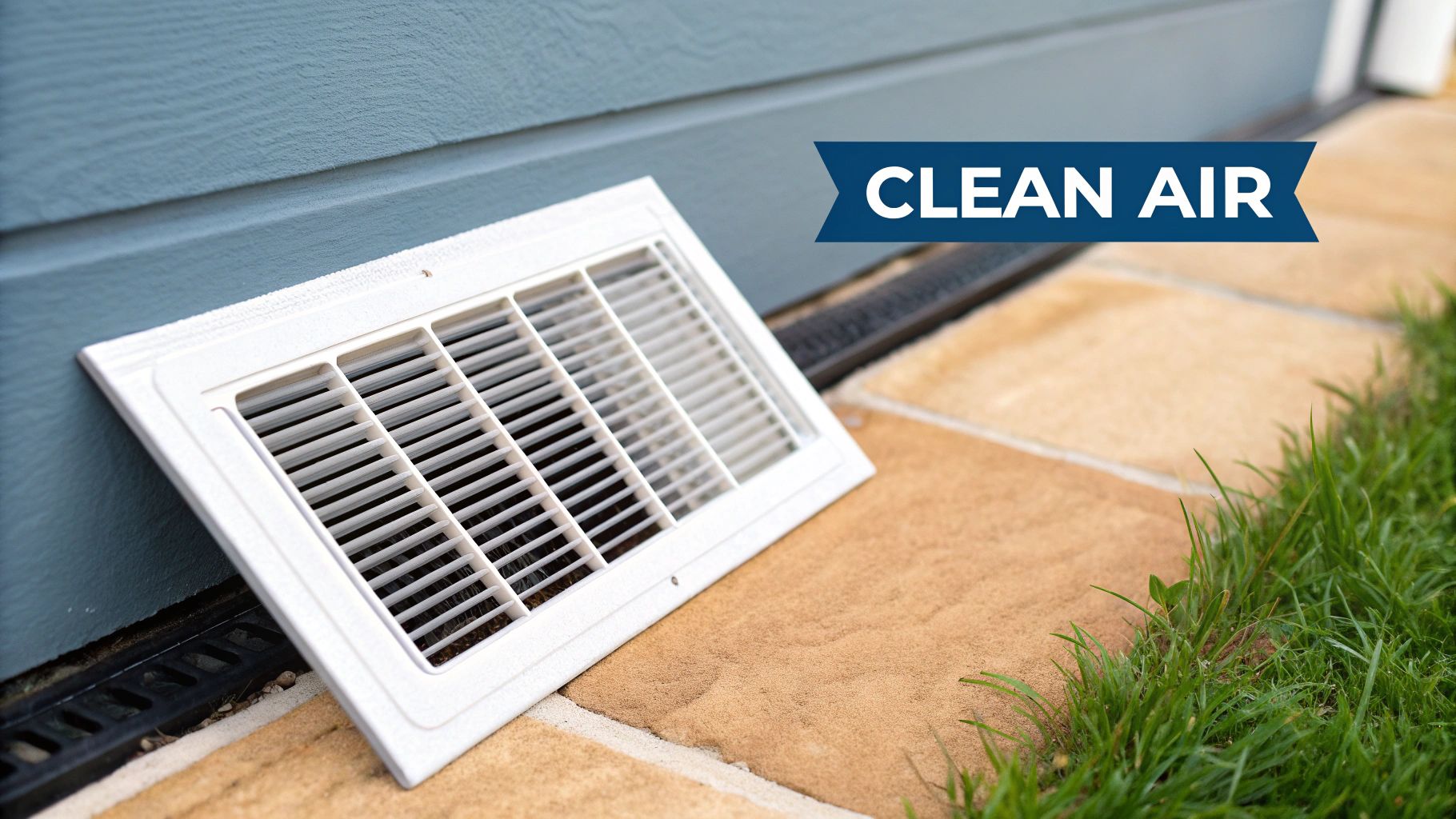
Think of an air vent filter like the screen on your window. It lets the fresh breeze in but keeps bugs and leaves out. Your home's air filters do pretty much the same thing for your HVAC system, acting as a gatekeeper that lets conditioned air flow through while blocking all the unwanted intruders.
These filters are truly the unsung heroes of a healthy home, working quietly behind the scenes to make your indoor environment cleaner and more comfortable.
Trapping Unseen Airborne Particles
Every single day, millions of tiny particles are swirling through your home's air. Without a good filter, you and your family are breathing them in constantly. A quality filter is designed to grab these contaminants right as they enter your HVAC system, stopping them long before they can blow out of the vents and into your rooms.
So, what exactly are these filters catching?
- Dust and Dust Mites: The stuff that makes up common household dust is a major source of indoor pollution.
- Pollen and Outdoor Allergens: A good filter keeps seasonal allergens from turning your home into a high-pollen zone.
- Pet Dander: If you have pets, you know dander is a constant battle. Filters are essential for trapping those tiny skin flakes that can trigger allergies.
- Mold Spores: By capturing airborne mold spores, filters help prevent them from finding a new place to land and grow.
By snagging all these irritants, filters for air vents create a much healthier environment. This is a huge deal for everyone, but it’s especially important for kids, older adults, and anyone dealing with asthma or allergies.
A clean air filter not only improves air quality but also reduces strain on your HVAC system, potentially lowering energy costs by preventing blockages that force the system to work harder.
Protecting Your Biggest Home Investment
Beyond just cleaning the air, these filters play a critical role in protecting your expensive HVAC system. The fan, coils, and other moving parts are really sensitive to buildup. When dust and debris sneak past a clogged or flimsy filter, they coat these vital components, making the whole system struggle to heat or cool your home.
This extra strain means lower efficiency, which you'll see on your higher energy bills. Even worse, it increases the risk of a costly breakdown. A fresh, properly-fitted filter is one of the cheapest and easiest forms of "insurance" you can get for your HVAC unit. When you stop seeing it as a chore and start seeing it as a crucial investment, you're taking a big step toward maintaining your home’s health and value.
Decoding the Different Types of Air Vent Filters
Walking down the filter aisle at a home improvement store can be overwhelming. You're faced with a wall of options, a bunch of acronyms, and a wide range of prices. How do you possibly pick the right one?
The good news is, it's not as complicated as it seems. The easiest way to think about filters for air vents in home is to break them down into a "good, better, best" framework. This helps you match the filter's performance to what your home actually needs—whether you're just trying to protect your furnace or you're aiming for an allergen-free zone for your family.
H3: Good: Basic Fiberglass Filters
Let's start with the basics. Disposable fiberglass filters are the entry-level option, the ones you can usually spot by their flat design and often blue or green color. They're cheap and you can find them anywhere.
But here’s the thing: their main job isn't really to clean your air. It's to protect your HVAC system. The loose, spun-glass mesh is designed to catch the big stuff—lint, dust bunnies, and clumps of pet hair—that could clog up the sensitive parts of your furnace or air conditioner. They do that job just fine, but smaller irritants like pollen, mold spores, and fine dust sail right through.
- Best for: Homes without pets or significant allergy concerns, where the main goal is simply to protect the HVAC equipment at the lowest cost.
- Replacement Schedule: Plan on swapping these out every 30 days. They clog up fast.
H3: Better: Pleated Filters
This is where you'll find the sweet spot for most homeowners. Pleated filters are a huge step up from fiberglass and offer the best bang for your buck, balancing solid filtration with good airflow.
Their secret is in the design. The filter material is folded into an accordion-like shape, which dramatically increases the surface area available to trap gunk. This simple change allows them to grab much smaller particles, including the stuff that actually makes you sneeze, like pollen, pet dander, and mold spores. They do all this without choking off the airflow your HVAC system needs to run efficiently.
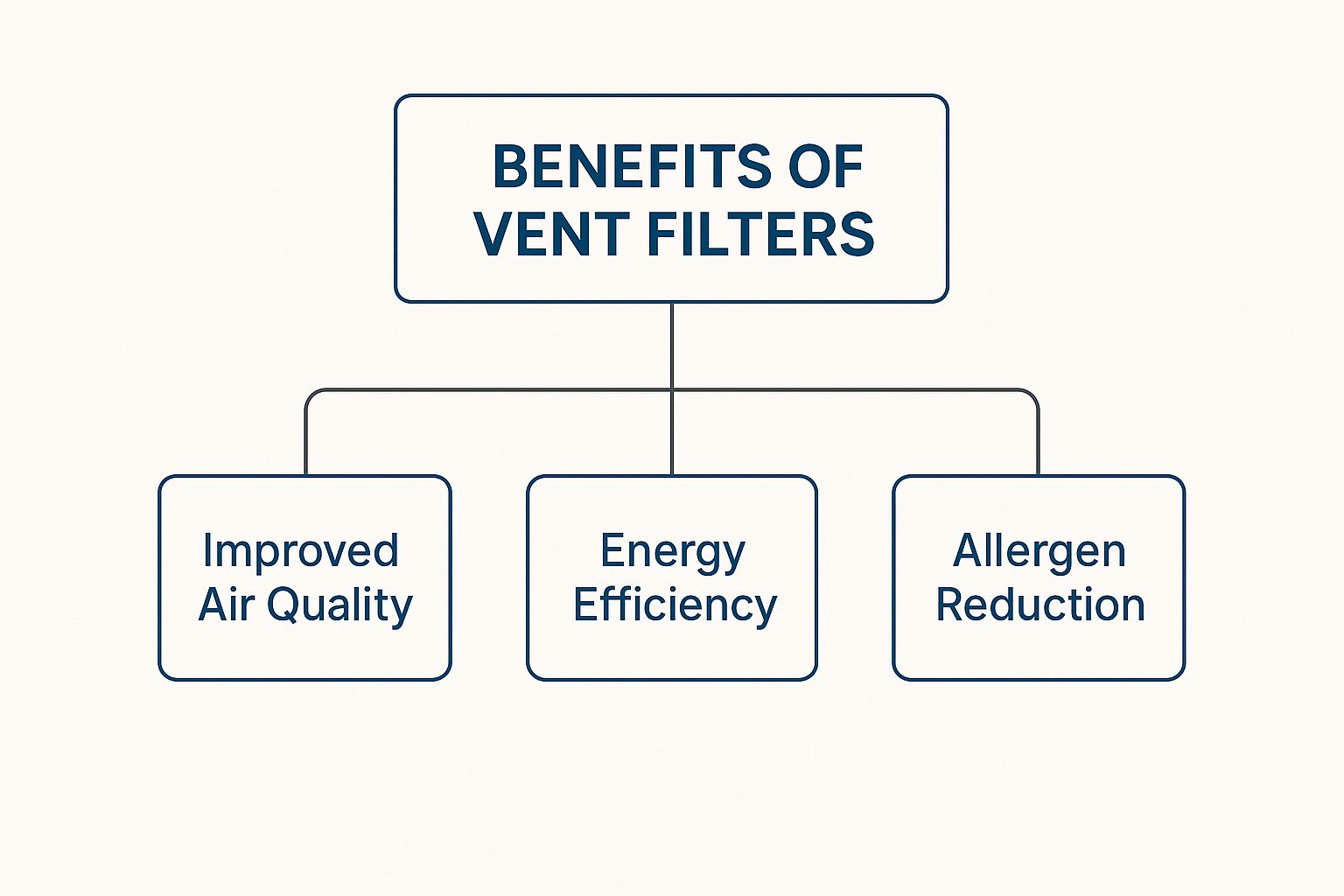
As the image shows, better filtration directly leads to cleaner air. This simple upgrade has a ripple effect, creating a healthier home and helping your heating and cooling system work better.
H3: Best: High-Efficiency and Electrostatic Filters
When clean air is non-negotiable, you move into the high-performance category. This is where you find high-efficiency filters like electrostatic and HEPA-style models, which are engineered to capture the tiniest, most troublesome airborne particles.
Electrostatic filters are pretty clever; they use self-charging fibers that act like a magnet for microscopic dust and dander. Many are washable and reusable, which can save you money in the long run. HEPA-style filters, on the other hand, offer the peak of residential filtration, capturing 99% or more of particles like smoke, bacteria, and other pollutants you can't even see.
People are paying more attention than ever to respiratory health, and it shows. The global market for residential air filters has grown to about USD 5.81 billion. High-performance filters are driving that trend because they are simply unmatched at removing the fine particulate matter that impacts our health the most.
Comparing Common Home Air Vent Filter Types
Choosing the right filter often comes down to a direct comparison. This table breaks down the most common types to help you see the key differences at a glance, from what they're made of to where they shine.
| Filter Type | Primary Material | Typical MERV Range | Key Benefit | Best For |
|---|---|---|---|---|
| Fiberglass | Spun Glass Fibers | 1-4 | Very low cost, basic equipment protection | Protecting the HVAC unit from large debris on a tight budget. |
| Pleated | Polyester or Cotton Paper | 5-11 | Excellent balance of filtration, airflow, and cost | General residential use, especially homes with pets or mild allergies. |
| Electrostatic | Electrically Charged Fibers | 8-12 | Reusable and effective at trapping small particles | Eco-conscious homeowners who want strong filtration without repeat buys. |
| High-Efficiency (HEPA) | Dense, Fine Fibers | 13-16 | Superior removal of microscopic allergens and pollutants | Homes with severe allergies, asthma, or compromised immune systems. |
Ultimately, the "best" filter is the one that best fits your home's specific air quality needs and your budget.
H3: Understanding MERV Ratings
So how do you actually measure a filter's power? That's where the MERV rating comes in. MERV stands for Minimum Efficiency Reporting Value, and it's a standard scale from 1 to 20 that tells you exactly how effective a filter is at trapping particles of different sizes.
The rule is simple: a higher MERV number means better filtration.
Think of it like a fishing net. A net with large holes (a low MERV rating) will only catch the big fish, letting all the smaller ones swim right through. A net with very fine mesh (a high MERV rating) will catch almost everything. It’s the same with air filters; a high-MERV filter has a denser weave that captures more of the microscopic stuff floating around in your home.
Here’s a quick guide to what those numbers mean for you:
- MERV 1-4: Catches the big stuff like pollen, dust mites, and carpet fibers. This is your standard fiberglass filter.
- MERV 5-8: Grabs finer particles like mold spores and pet dander. Most pleated filters fall in this range, which is perfect for the average home.
- MERV 9-12: Traps even smaller things, like lead dust and auto emissions. This is an excellent choice for anyone with allergies.
- MERV 13-16: Now we're talking about bacteria, tobacco smoke, and even some virus-carrying particles. This is considered high-efficiency for home use.
How to Choose the Right Filter for Your Home
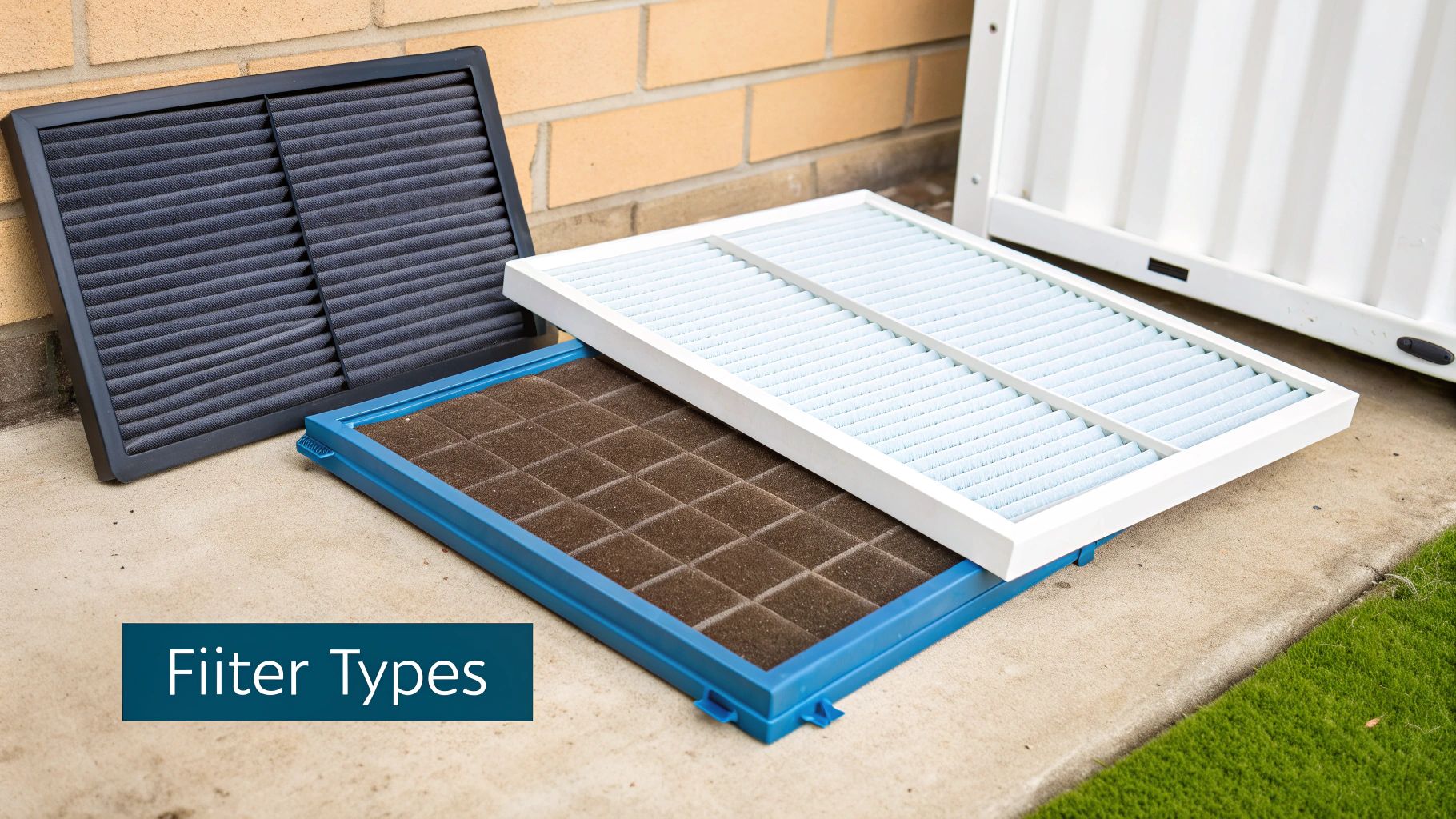
Picking the perfect filter isn't about just grabbing the most expensive one off the shelf. It’s all about finding the right match for your home, your family’s health, and what your HVAC system can actually handle. A few key considerations can turn a confusing choice into a simple decision.
Think about your specific living situation. Do you have pets leaving a trail of dander? Does someone in your family struggle with asthma or seasonal allergies? Answering these simple questions is the first step toward finding the ideal filters for air vents in home that will truly make a difference.
Match Your Filter to Your Lifestyle
The air inside your home is unique to your life. A filter that works just fine for a single person in a small apartment might not cut it for a busy family with a dog and a cat.
Start by figuring out what your home really needs. This checklist should help.
- Pets: Our furry friends bring a lot of love, but they also bring a lot of dander. A mid-range pleated filter (MERV 8-11) is a must-have to capture those tiny skin flakes that can trigger allergies.
- Allergies or Asthma: If anyone in your home deals with respiratory issues, you'll want to step up your game. A higher-rated filter (MERV 11-13) can do wonders by trapping more irritants like pollen, mold spores, and dust mite debris.
- Location: Live in an area with a high pollen count, constant construction, or wildfire smoke? You're fighting an uphill battle against pollutants from outside. A higher MERV filter can be your first line of defense.
- Smokers: Tobacco smoke particles are incredibly small and tough to catch. To be effective, you'll need a filter with a MERV rating of 13 or higher.
This personalized approach helps ensure you’re not overpaying for filtration you don't need or, even worse, under-protecting your family from the pollutants that matter most.
Balance Filtration Power with Airflow
This is a big one. It's absolutely critical to balance a filter's cleaning power (its MERV rating) with your HVAC system’s ability to move air. Using a filter that’s too restrictive is like trying to breathe through a coffee stirrer while jogging—it puts a massive strain on your system.
A high-MERV filter has a very dense weave, which is great for trapping microscopic particles. The flip side is that this density makes it much harder for air to pass through. This resistance forces your HVAC system’s fan motor to work overtime just to pull air in.
When a filter is too restrictive for your system, it can lead to poor heating and cooling, higher energy bills, and even cause your equipment to fail prematurely. Finding that sweet spot is key.
So, how do you know what your system can handle? Most residential HVAC systems are built to work best with filters in the MERV 8-11 range. If you're considering a filter rated MERV 13 or higher, it's a smart move to check your system's manual or ask an HVAC pro. Keeping up with regular AC maintenance can also help a technician spot if your system is struggling with airflow.
Find the Right Filter Size Every Time
The last piece of the puzzle is the simplest, but it’s where most people mess up: buying the wrong size. An ill-fitting filter lets air—and all the dust it’s carrying—sneak around the edges, making the filter almost useless.
Luckily, finding the right size is easy.
- Check the Old Filter: The dimensions are almost always printed right on the cardboard frame. Look for three numbers, like 16x25x1.
- Measure the Slot: If the numbers have faded away, just slide the old filter out and use a tape measure to find its length, width, and depth.
Getting the size right guarantees a snug fit, forcing every bit of air through the filter media. It's a simple step that makes sure your investment in quality filters for air vents in home actually pays off. This focus on indoor air quality has helped the U.S. furnace filter market grow to around USD 1.06 billion. You can learn more about this trend and why people are choosing higher MERV filters over at Grand View Research.
A Simple Guide to Installing Your Air Vent Filter
Changing out your home's main air filter is one of the easiest and most important DIY jobs you can do. Seriously, it takes just a few minutes, but it makes a world of difference for your air quality and the health of your HVAC system. You don't need any fancy tools or technical know-how—just the right filter and a little guidance.
Think of it like changing the oil in your car. It’s a basic maintenance task that keeps the whole machine running the way it should. If you let it go, you're setting yourself up for much bigger, more expensive headaches later on.
Step-by-Step Filter Installation
Getting this done is pretty simple, but there's one little detail that can trip people up. Follow these steps, and you'll get it right every time.
-
Find the Filter Housing: First things first, you need to find where the filter lives. It's almost always located inside your house, right on the furnace or air handler unit itself. Check your utility closet, basement, or attic. You're looking for a slot with a cover that's about 1-inch wide, often with a small tab or handle to open it.
-
Take Out the Old Filter: Just slide the old, dirty filter straight out. Take a good look at it—if it’s caked in a grey layer of dust and gunk, you’ll feel great about getting it out of there. This is also the perfect moment to check the size printed on the filter's cardboard frame to make sure your new one is the exact same.
-
Put the New Filter in Correctly: Pay attention here, because this is the most critical part. Your new filter has arrows printed on the frame. These arrows must point toward the furnace blower motor—in other words, in the same direction the air is flowing. A filter put in backward just won't work properly. Slide the new one all the way in and pop the cover back on.
That little airflow arrow shows which way the air is moving through your system. Pointing it away from the return duct and toward the furnace guts ensures it traps particles correctly. Getting this one small detail right is key to effective filtration.
For homeowners tackling a much larger project, like a full system replacement, understanding proper installation is vital. When professionals handle a complete AC installation, they make sure every single component, right down to the filter, is set up for peak performance from the start.
How Often Should You Really Change Your Filter?
You’ve probably heard the old "change it every 90 days" rule. That’s not bad advice, but it's more of a general guideline than a hard-and-fast rule. How often you should change the filters for air vents in home really comes down to what’s going on in your house.
Your replacement schedule should be based on your unique environment:
- Average Home (No Pets): Every 60-90 days is a pretty good schedule.
- Home with One Pet: You’ll want to bump that up to every 45-60 days to handle the extra dander and hair.
- Homes with Multiple Pets or Allergies: Check it monthly, and plan on swapping it out every 30-45 days to keep the air clean.
- Smokers in the Home: Tobacco smoke clogs filters fast. A monthly change is definitely the way to go.
Making a habit of changing your filter is a simple task that pays you back with cleaner air, a more efficient HVAC system, and fewer surprise repair bills. It’s a small effort with a big payoff.
The Hidden Rewards of Changing Your Filters Regularly
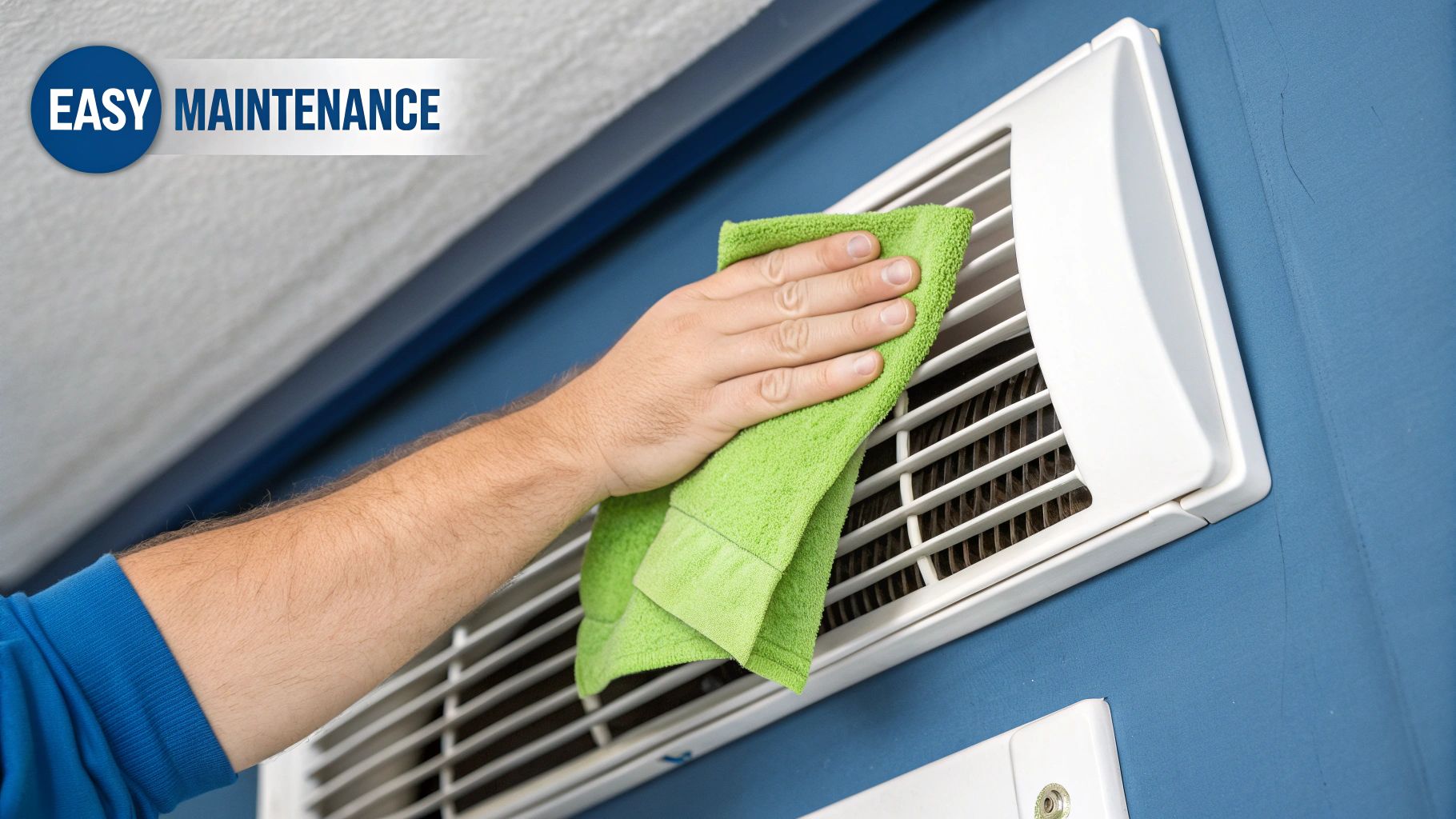
Sure, changing your air filter means you get cleaner air. That’s the obvious part. But the real benefits of this simple habit run much deeper, affecting everything from your wallet to the lifespan of your most expensive home appliance. It’s easily one of the most impactful home maintenance tasks you can do.
Think of it this way: your HVAC system is like a marathon runner. A clean filter is like taking a deep, easy breath, letting the system perform at its peak without any struggle. But a dirty, clogged filter? That's like forcing the runner to breathe through a coffee stirrer. Everything becomes a massive strain.
Lower Your Energy Bills
When your system can "breathe" easily, it doesn't have to fight to pull air in and push it through your home. That efficiency has a direct impact on your energy bill. A clogged filter makes the fan motor work overtime, running longer and harder, which can send your utility costs soaring.
We’re not talking about pocket change, either. Keeping the filters for air vents in home clean is one of the most powerful ways to cut down on energy use. For just a few minutes and a few bucks every couple of months, you ensure your system isn't wasting energy, saving you real money year-round.
It’s no surprise the global air filters market is expected to grow from USD 18.66 billion to USD 32.86 billion by 2035. People are catching on to the importance of efficiency and clean air, driving innovation and demand.
Extend the Life of Your HVAC System
Your HVAC unit is a huge investment. Protecting it should be a top priority, and a clean filter is your first line of defense. That strain from a dirty filter doesn't just hike up your bills—it also puts a ton of wear and tear on the system's components.
When airflow is choked off, the fan motor gets overworked, parts can overheat, and the whole system is put under constant stress. Over time, that stress leads to premature breakdowns and expensive repairs that were completely avoidable.
Think of filter changes as preventative medicine for your HVAC system. This one small habit helps sidestep the most common reasons for system failure, potentially adding years to your equipment's life.
Of course, this works best when paired with professional tune-ups. To see the whole picture, it's worth learning more about how regular maintenance extends your AC's lifespan and works together with your own efforts.
Enjoy a Cleaner Home with Less Work
Finally, there’s the reward you can actually see: a much cleaner house. A good filter is incredible at trapping dust, pet dander, and all sorts of other gunk before it ever gets a chance to settle on your furniture, floors, and countertops.
This is a win-win situation:
- Less Dusting: You’ll notice a lot less dust building up, which means less time spent cleaning.
- A Fresher Feel: Your home will simply feel cleaner and more pleasant to be in.
This quick, five-minute task is a true triple threat—it improves your air, protects your HVAC, and cuts down on your cleaning chores. It's a small effort with a massive payoff.
Still Have Questions About Home Air Vent Filters?
It's one thing to understand the basics, but it's another to know exactly what to do in your own home. Let's tackle some of the most common questions and tricky situations people run into when dealing with their air vent filters.
Think of this as the practical advice you'd get from a seasoned pro. We'll clear up the confusion so you can feel confident you're doing what's best for your home's air and your HVAC system.
Should I Put Extra Filters in My Room Vents?
You’ve probably seen those small filters that fit right into your room's supply vents, often called register filters. They can be a great secondary line of defense, catching any dust or pet hair that made it past your main filter or settled inside your ducts.
These are particularly handy for rooms where air quality is a top priority, like a nursery or the bedroom of someone with bad allergies. Just remember, they are not a replacement for your main HVAC filter. Also, keep in mind they can slightly slow down the airflow into a room, so you'll need to clean or replace them regularly to avoid putting a strain on your system.
Is a Higher MERV Rating Always Better?
Not necessarily. It’s tempting to think the highest number is the best, but that’s not how HVAC systems work. A higher MERV rating means the filter material is denser, which makes it harder for air to push through. Imagine trying to breathe through a thick wool blanket versus a cotton t-shirt—that's the difference your HVAC system feels.
If your system was designed for a MERV 8 filter and you install a MERV 13, you're forcing the fan motor to work overtime. This can cause some serious problems:
- Higher energy bills as your system struggles to circulate air.
- Poor heating and cooling because the airflow is choked off.
- A shorter lifespan for your system due to the constant stress on its components.
Always check your HVAC owner's manual or ask a technician for the maximum MERV rating your system can handle. Pushing it past its limit is a recipe for costly repairs down the road.
What If My Filter is a Weird Size I Can't Find in Stores?
This is a really common headache, especially in older homes or custom builds where nothing seems to be a standard size. If you've measured twice and still can't find a filter that fits, don't worry—you have options.
Many online filter retailers will build a custom-sized filter for your air vents at home and ship it right to your door. This is usually the easiest route. You could also try a local HVAC supply house; they often carry a much wider range of sizes than the big hardware stores. Whatever you do, don't try to cut a larger filter to fit. That almost always damages the frame and ruins its ability to seal and filter properly.
At Florida Cooling Group, our certified technicians can help you sort out these questions and any others you might have. We’ll make sure your HVAC system has the right filter to give you the best performance and cleanest air. Schedule a maintenance check with us today to get your system running at its peak.

 (561) 400-2205
(561) 400-2205

